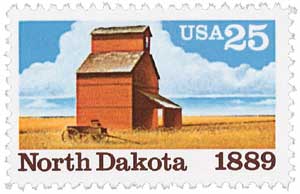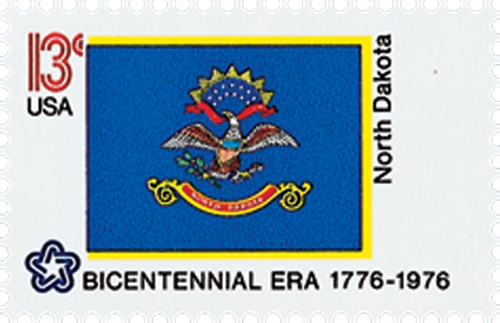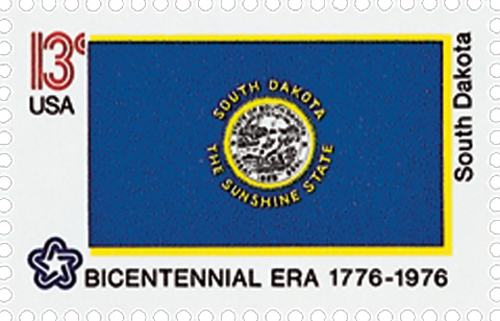
# 3601 FDC - 2002 34c Greetings From America: South Dakota
Â
South Dakota
34¢ Greetings From America
City: New York, NY
Quantity:Â 200,000,000
Printed by:Â American Packaging Corp for Sennett Security Products
Printing Method: Photogravure
Perforations: Serpentine Die Cut 10.75
Quantity:Â 200,000,000
North And South Dakota Admitted To The Union
Two American Indian tribes lived in North and South Dakota before the arrival of Europeans – the Arikara and the Cheyenne. North Dakota was also home to the Hidatsa and Mandan. In the beginning of the 1700s, the Sioux moved to South Dakota from Minnesota.
Réne-Robert Cavelier, Sieur de La Salle, claimed all the land drained by the Mississippi River system for France in 1682. This included portions of both North and South Dakota. French-Canadian brothers François and Louis-Joseph La Vérendrye were the first whites to reach North and South Dakota.
In 1803, France sold Louisiana to the United States. In 1804, President Thomas Jefferson sent Meriwether Lewis and William Clark on an expedition to explore the Louisiana Territory. They passed through both regions on their way home and established friendly relations with the Indian tribes of the area.
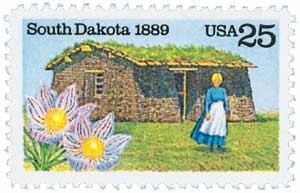
Canadians of Scotch and Irish descent were the first Europeans to attempt a permanent settlement in North Dakota. They settled in Pembina in 1812. In 1818, the U.S. gained control of the northeastern portion of the state through a treaty with Great Britain. This treaty made all of today’s North Dakota U.S. territory. Most of the settlers at Pembina left soon after the treaty was signed, as they wished to remain in British territory.
The first permanent settlement in South Dakota was built in 1817 on the site of Fort Pierre on the Bad River. A French trader, Joseph La Framboise, established the fort. The increased number of Europeans in South Dakota created tensions with the American Indian populations. The Arikara tribe attacked a fur-trading party led by the lieutenant governor of Missouri, General William Ashley. Federal troops were dispatched to punish the tribe.
Congress created the Dakota Territory in 1861. It included the modern states of North and South Dakota, as well as large parts of Montana and Wyoming. In 1863, the Dakota Territory was opened for homesteading. Settlers received free land to live on and improve. Even with the incentive of free land, the territory developed slowly. This was due to poor transportation and fear of Indian attacks.
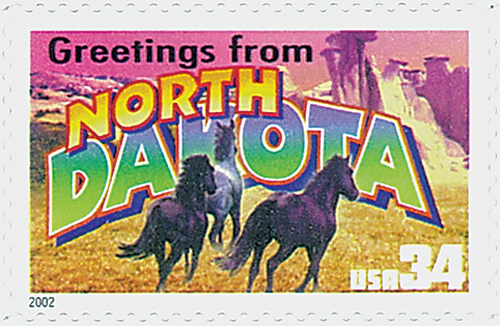
In the 1860s, conflicts with American Indians prevented rapid settlement of the Dakota Territory. The most significant fighting was during Red Cloud’s War. Red Cloud was a Sioux chief. He opposed the construction of a bridge that was being built to facilitate the mining of gold located in prime Sioux hunting lands. From 1866-68, the Sioux attacked troops and settlers. Finally, the government met their demands and created the Great Sioux Reservation, which included all the land in South Dakota west of the Missouri River.
In 1875, large-scale farming became a profitable business in the Dakota Territory. Eastern corporations and wealthy families established huge wheat farms ranging in size from 3,000 to 65,000 acres. Most of these farms were located in the Red River Valley. These wheat farms earned so much money, they became known as bonanza farms. Improved machinery and orderly methods of planting, harvesting, and marketing were the keys to success of the bonanza farms.
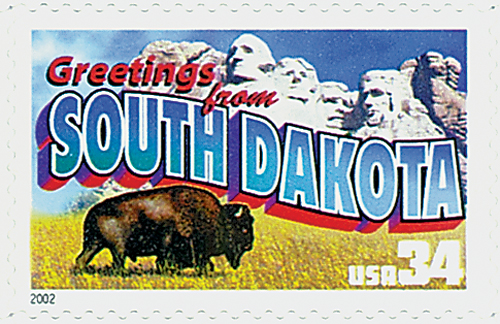
Also in the mid 1870s, a military expedition into the Black Hills, led by Lieutenant Colonel George A. Custer, discovered gold near the present-day town of Custer. In 1876, even larger deposits were found near today’s towns of Lead and Deadwood. These discoveries created a rush of gold prospectors to the area. Lawless mining towns grew in these areas. Deadwood was of particular notoriety. Wild Bill Hickok, Calamity Jane, and other Deadwood citizens grew to become American legends.
The discovery of gold and the availability of excellent farmland attracted many thousands of settlers. Railroads were built. Cattle ranchers were attracted to the area, as there was a huge demand for meat.
During the 1870s, the people of the Dakota Territory began asking Congress to divide their territory into two parts. The main population centers in the territory were in the northeast and southeast and had little contact. Travel between the two was difficult, as the railroads had been laid out in an east-to-west direction. Each group had separate interests and therefore wanted separate government. The border between North and South Dakota was established in February 1889. On November 2, 1889, North and South Dakota were admitted to the union as their own states.
After becoming a state, North Dakota’s population and farm production grew rapidly. However, the farmers disliked the power of banks, grain companies, and railroad interests from Minnesota. They also felt these out-of-state businesses had too much influence on North Dakota’s politics. As a result, the Nonpartisan League was founded. This farmer-led organization called for state ownership of grain elevators, flourmills, packinghouses, and cold storage plants. It also asked for bank loan reforms.
During the Great Depression of the 1930s, North Dakota’s farms were also struck with a drought that increased the state’s economic suffering. Farming recovered with the start of World War II. All of the state’s records for food production were broken during the war. After the war, food surpluses and lower prices, coupled with new farm machinery, meant changes for the economy. Unemployment grew. Some people found work in cities; others left the state. In 1951, oil was discovered near Tioga. Oil became North Dakota’s most valuable resource. By 1970, there were oil wells operating in 14 counties in the western half of the state.
During the 1970s, North Dakota’s government began working to broaden its economy. Production of coal, oil, and natural gas was greatly increased. Lower oil prices during the 1980s had a damaging effect on North Dakota’s economy. The efforts to attract new industries to the state have met with some success. New jobs are created, but not fast enough to offset the decline in farm jobs.
South Dakota’s growth for its first 10 years as a state was stunted by a severe drought. New Indian lands were made available for settlement and awarded by means of special lotteries. By 1910, the state’s population had grown to 584,000. South Dakota’s economy cycled through highs and lows, due to droughts, for many years. During World War II, South Dakota’s farmers eventually recovered and broke food production records.
Since World War II, South Dakota’s government has worked hard to broaden its economy and attract new industries. These efforts were especially successful during the 1970s. But, during the 1980s, a large number of the state’s farmers were forced to sell their land due to low prices and high debts. To encourage growth, the state does not tax personal or corporate income. South Dakota has very little pollution, with extremely clean air and water.
Â
Â
South Dakota
34¢ Greetings From America
City: New York, NY
Quantity:Â 200,000,000
Printed by:Â American Packaging Corp for Sennett Security Products
Printing Method: Photogravure
Perforations: Serpentine Die Cut 10.75
Quantity:Â 200,000,000
North And South Dakota Admitted To The Union
Two American Indian tribes lived in North and South Dakota before the arrival of Europeans – the Arikara and the Cheyenne. North Dakota was also home to the Hidatsa and Mandan. In the beginning of the 1700s, the Sioux moved to South Dakota from Minnesota.
Réne-Robert Cavelier, Sieur de La Salle, claimed all the land drained by the Mississippi River system for France in 1682. This included portions of both North and South Dakota. French-Canadian brothers François and Louis-Joseph La Vérendrye were the first whites to reach North and South Dakota.
In 1803, France sold Louisiana to the United States. In 1804, President Thomas Jefferson sent Meriwether Lewis and William Clark on an expedition to explore the Louisiana Territory. They passed through both regions on their way home and established friendly relations with the Indian tribes of the area.

Canadians of Scotch and Irish descent were the first Europeans to attempt a permanent settlement in North Dakota. They settled in Pembina in 1812. In 1818, the U.S. gained control of the northeastern portion of the state through a treaty with Great Britain. This treaty made all of today’s North Dakota U.S. territory. Most of the settlers at Pembina left soon after the treaty was signed, as they wished to remain in British territory.
The first permanent settlement in South Dakota was built in 1817 on the site of Fort Pierre on the Bad River. A French trader, Joseph La Framboise, established the fort. The increased number of Europeans in South Dakota created tensions with the American Indian populations. The Arikara tribe attacked a fur-trading party led by the lieutenant governor of Missouri, General William Ashley. Federal troops were dispatched to punish the tribe.
Congress created the Dakota Territory in 1861. It included the modern states of North and South Dakota, as well as large parts of Montana and Wyoming. In 1863, the Dakota Territory was opened for homesteading. Settlers received free land to live on and improve. Even with the incentive of free land, the territory developed slowly. This was due to poor transportation and fear of Indian attacks.

In the 1860s, conflicts with American Indians prevented rapid settlement of the Dakota Territory. The most significant fighting was during Red Cloud’s War. Red Cloud was a Sioux chief. He opposed the construction of a bridge that was being built to facilitate the mining of gold located in prime Sioux hunting lands. From 1866-68, the Sioux attacked troops and settlers. Finally, the government met their demands and created the Great Sioux Reservation, which included all the land in South Dakota west of the Missouri River.
In 1875, large-scale farming became a profitable business in the Dakota Territory. Eastern corporations and wealthy families established huge wheat farms ranging in size from 3,000 to 65,000 acres. Most of these farms were located in the Red River Valley. These wheat farms earned so much money, they became known as bonanza farms. Improved machinery and orderly methods of planting, harvesting, and marketing were the keys to success of the bonanza farms.

Also in the mid 1870s, a military expedition into the Black Hills, led by Lieutenant Colonel George A. Custer, discovered gold near the present-day town of Custer. In 1876, even larger deposits were found near today’s towns of Lead and Deadwood. These discoveries created a rush of gold prospectors to the area. Lawless mining towns grew in these areas. Deadwood was of particular notoriety. Wild Bill Hickok, Calamity Jane, and other Deadwood citizens grew to become American legends.
The discovery of gold and the availability of excellent farmland attracted many thousands of settlers. Railroads were built. Cattle ranchers were attracted to the area, as there was a huge demand for meat.
During the 1870s, the people of the Dakota Territory began asking Congress to divide their territory into two parts. The main population centers in the territory were in the northeast and southeast and had little contact. Travel between the two was difficult, as the railroads had been laid out in an east-to-west direction. Each group had separate interests and therefore wanted separate government. The border between North and South Dakota was established in February 1889. On November 2, 1889, North and South Dakota were admitted to the union as their own states.
After becoming a state, North Dakota’s population and farm production grew rapidly. However, the farmers disliked the power of banks, grain companies, and railroad interests from Minnesota. They also felt these out-of-state businesses had too much influence on North Dakota’s politics. As a result, the Nonpartisan League was founded. This farmer-led organization called for state ownership of grain elevators, flourmills, packinghouses, and cold storage plants. It also asked for bank loan reforms.
During the Great Depression of the 1930s, North Dakota’s farms were also struck with a drought that increased the state’s economic suffering. Farming recovered with the start of World War II. All of the state’s records for food production were broken during the war. After the war, food surpluses and lower prices, coupled with new farm machinery, meant changes for the economy. Unemployment grew. Some people found work in cities; others left the state. In 1951, oil was discovered near Tioga. Oil became North Dakota’s most valuable resource. By 1970, there were oil wells operating in 14 counties in the western half of the state.
During the 1970s, North Dakota’s government began working to broaden its economy. Production of coal, oil, and natural gas was greatly increased. Lower oil prices during the 1980s had a damaging effect on North Dakota’s economy. The efforts to attract new industries to the state have met with some success. New jobs are created, but not fast enough to offset the decline in farm jobs.
South Dakota’s growth for its first 10 years as a state was stunted by a severe drought. New Indian lands were made available for settlement and awarded by means of special lotteries. By 1910, the state’s population had grown to 584,000. South Dakota’s economy cycled through highs and lows, due to droughts, for many years. During World War II, South Dakota’s farmers eventually recovered and broke food production records.
Since World War II, South Dakota’s government has worked hard to broaden its economy and attract new industries. These efforts were especially successful during the 1970s. But, during the 1980s, a large number of the state’s farmers were forced to sell their land due to low prices and high debts. To encourage growth, the state does not tax personal or corporate income. South Dakota has very little pollution, with extremely clean air and water.
Â






